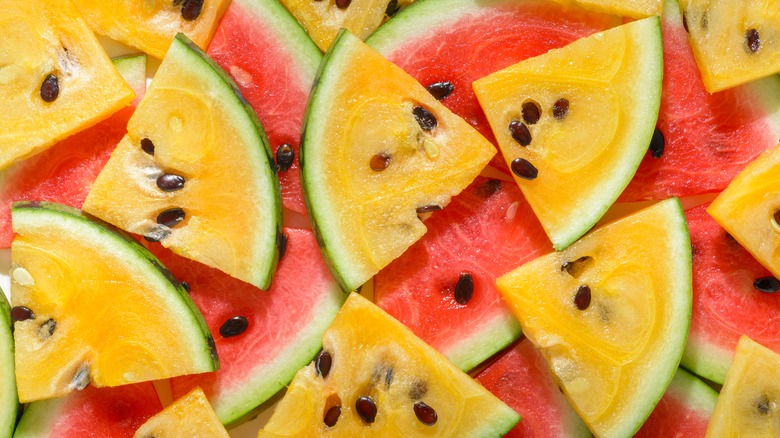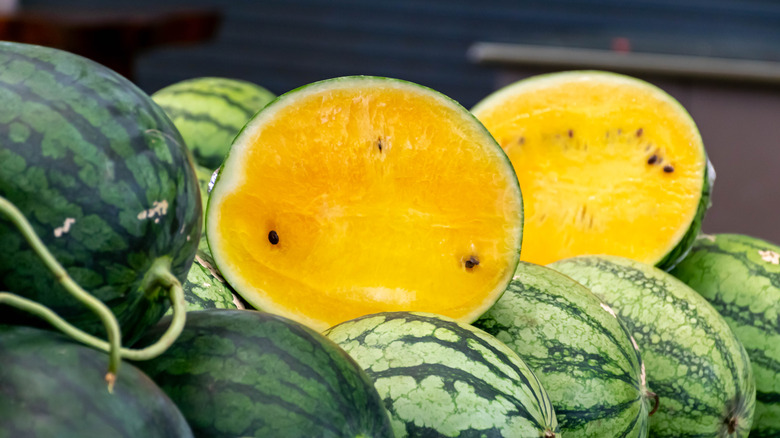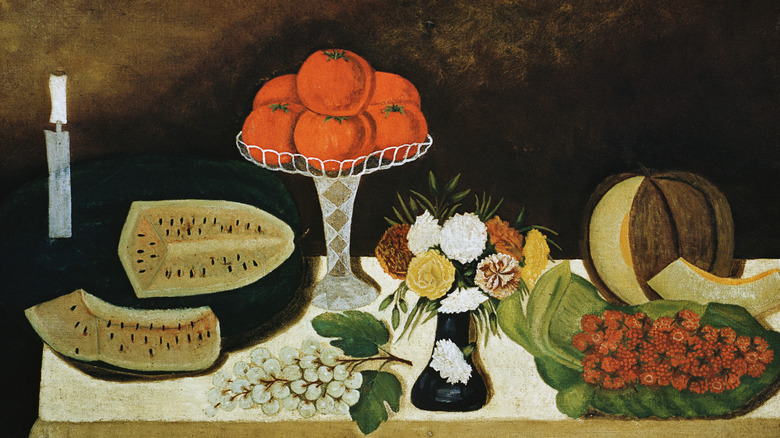Is There A Flavor Difference Between Pink And Yellow Watermelons?
These days, stepping into the produce aisle feels like stepping into Oz. Fruit has always been colorful, but if you feel like it's gotten more colorful (and weirder) in the past few years, you're not alone. Thanks to advances in breeding techniques and rising demand for Instagramable grocery hauls, crazy color combos are cropping up everywhere. Now you can buy pricy pineapples with pretty pink innards, tomatoes in deep purple hues, and what's the deal with those yellow watermelons? Do they taste like the red watermelons you're used to?
Not all of these technicolor fruits taste like their conventionally-hued counterparts, but yellow watermelons don't stray far from familiar territory. They have the same crisp bite and juicy texture. The flavor is pretty similar, too, though yellow watermelons err on the sweeter side — sweeter than most red melons, anyway. Fans describe notes of honey with some varieties tasting a bit like apricot.
Yellow watermelons are similar enough to the red variety to use in the same recipes. You can mix yellow watermelons in with red to add a spark of color to a watermelon salad or grill them for a sweet-yet-smoky flavor. Blend yellow watermelons into cocktails, then mess with your guests by asking them to guess the star ingredient. But yellow watermelons are distinct. Their startlingly sweet flavor, unique color, and interesting history make them a worthy grocery store splurge.
Yellow watermelons come in a range of flavors and varieties
There are different varieties of yellow watermelon, each with a distinct flavor profile. Exceptional sweetness is an overarching theme, but taste and texture also vary. Some varieties are takes on familiar favorites. For example, Yellow Crimson melons are sunny cousins of the Crimson Sweet variety, though they take the Crimson Sweet's sugary flavor to the next level. Yellow Flesh Black Diamonds look just like the popular, dark-skinned Black Diamond variety — at least from the outside. The melon is sweet and flavorful, but not as saccharine as most yellow watermelons.
Others, like the Buttercup Yellow variety, stand on their own. Buttercup Yellow is a must-try for any watermelon lover with a serious sweet tooth as it's one of the sweetest varieties. Slice open a Desert King and you might mistake the innards for cantaloupe flesh. Rest assured, the dense, pale orange melons still taste like watermelon.
Since yellow watermelons are a novelty, grocery stores typically don't provide info on the variety. Want to get a taste of a specific kind? Ask around at farmers markets. If all else fails, you could try growing them yourself.
Yellow watermelons are the original
Unlike purple tomatoes and pink pineapples, yellow watermelons aren't GMOs — they're actually the OGs. When humans started cultivating watermelons in Africa over 5,000 years ago, the fruits featured bright yellow flesh. Ancient Egyptians used the colorful melons as a water supply on long journeys. Scientists originally speculated that watermelons were descended from egusi melons, a bitter, inedible melon from West Africa. But recent research says they're closer to Kordofan melons, a sweeter, milder variety from East Africa. Kordofan melons have a light yellow tinge, though they're not the same vivid color that you see in yellow watermelons today.
Watermelons evolved through selective breeding. Pink hues started to appear during the 18th Egyptian dynasty as the melons developed higher levels of Lycopene, a red-hued antioxidant. By the time watermelons started spreading outside Africa sometime between 400 BCE and 500 CE, watermelons with red flesh were nothing new.
These days, red is the default hue. Yellow watermelons are hard to come by, even as shoppers warm to crazy-colored fruit. Look for them in mid-to-high-priced grocery stores, since you probably won't find them in discount chains. Checking specialty produce stores and farmers markets will boost your chances as well. If you do manage to find them, stick to the same tried-and-true rules you'd use to pick any watermelon. Give the melons a thump, check the stem, and look for a yellow spot on the bottom.


